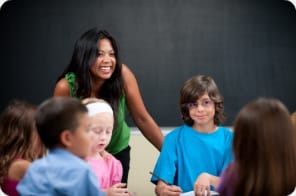Early Childhood Teaching Certification

Early childhood is a unique developmental period, requiring similarly unique teaching strategies and styles.
Children are driven by a natural curiosity and determination that makes them perfect learners. Teachers learn how to harness this curiosity, setting their students on the path to a love of learning.
They understand the developmental changes that accompany childhood, and guide their students as they explore new areas of life.
On This Page…
| Certification: What does it mean? |
| Knowledge of Developmental Changes |
| Need to know subjects… |
| Becoming Certified |
| Managing Classroom Behavior |
| Find Schools offering teaching certification programs |
But to become qualified to teach these children, early education teachers must first become certified.
With a thorough understanding of childhood development and knowledge of the academics surrounding early childhood education, potential teachers are well prepared for the certification process.
Certification: What does it mean?
An early childhood education certification denotes that a teacher has met a set of standards that shows they understand the best ways to educate young students aged 3 to 8. Certification is a rigorous process, where student teachers must complete teacher education programs, and sometimes must pass exams.
Certified teachers display academic aptitude, and are patient, compassionate individuals who best know how to nurture children’s drive to learn.
Because certification requirements are different for each state, prospective teachers can check their state’s requirements here.
Knowledge of developmental changes
Certified teachers must understand the early childhood developmental changes in order to effectively reach early learners. During childhood, concepts of the world change, as children learn to interact with others, develop increased language comprehension, and experience new emotions, events, and feelings.
- Creative representation: drawing, painting, pretending, playing
- Language: describing, writing, learning to read, describing personal experiences
- Social interaction: making plans, decisions, solving problems, expressing feelings
- Movement: Move and play in various ways with different objects
- Logical Reasoning: Classifying, exploring, and describing similarities and differences
The certification standards require teachers to demonstrate an understanding of these developmental changes, and show how they adapt their lesson plans around cognitive development, language development, physical development, and personal development.
Teachers seeking certification must develop knowledge of the effects of biological, environmental, cultural, social, and economic factors on childhood development, and understand the importance of developing a creative and nurturing environment.
One of the biggest resources for teachers guiding students through these changes is play. Play is sometimes called the language of children, so teachers must develop a thorough understanding of how students learn and interact through play.
According to the Association for Childhood Education International (ACEI), play enhances the learning and development of all children. The ACEI notes that play encourages children to learn self-control, share power, and helps them learn the social skills that will follow them throughout their lives. It also builds creativity, attention, and logical reasoning skills.
Children are rambunctious and energetic, to the point where it can almost seem impossible to capture their attention at times.
For teachers in early education, classroom management strategies are an important part of the job, allowing educators to effectively halt negative behaviors, while reinforcing the positive ones.
Teachers looking toward certification should understand organized play, and learn about lessons and a comprehensive curriculum that incorporates it.
For example, certification requires teachers to show how they stimulate the cognitive and social development of young children. One way a teacher might do this is by organizing children into two groups where one group pretends to run a grocery store, and the other group buys goods.
The organized play session allows the children to use fake money to make transactions, teaching math skills, and encourages social interaction between the students.
Childhood development has a large influence on teacher curricula and lesson plans. Teachers seeking certification must understand how childhood development and school subjects combine to create effective curricula.
What subjects do early childhood teachers need to know?
Early childhood education certification standards dictate that teachers must have a thorough understanding of the basic school subjects they teach their students.
For most young learners, preschool and kindergarten are where they begin to learn their first language, math, science, and social studies skills. But these lessons are often presented in different ways compared to the teaching of older students.
Language Arts and Reading
To pass certification standards, teachers must understand the principles of planning and organizing reading instruction for children based on their developmental level. Teachers introduce phonological and linguistic skills to form a basis for reading and teaching students to understand basic story structure.
Important concepts in early childhood literacy include vocabulary development; awareness and knowledge of print, letters, and words; and understanding the basics of writing comprehension.
Certified teachers understand the relationship between oral language development, reading and writing, and children’s thinking abilities. They understand the principles of the alphabet, and how children begin to develop and build on the alphabet.
Building on children’s understanding of the alphabet, certified teachers direct children to develop the basic reading and story comprehension skills necessary to become fluent readers. Teachers should understand strategies like identifying main ideas in a story, predicting, paraphrasing, questioning, and using context clues.
Certification standards note that teachers must understand the role of problem-solving skills in reading comprehension, and show ways to promote these skills, such as acting out stories in class through dramatization. Dramatization captures the playfulness of early learners, and helps them work out stories and build an understanding of story structure.
Mathematics
Before becoming certified, teachers must understand basic number concepts and strategies for teaching the basis of numbers to children. This includes characteristics of number systems and number sequences, methods and materials that promote exploration of numbers, and the relationships between them.
Effective early childhood education teachers blend math in many areas of the classroom to instill basic number sense in children. For example, during lunch or snack time, the teacher might ask the children to split up the snacks between students in the class.
Certified teachers understand that the seemingly normal and everyday tasks of dividing up lunch or snacks helps young children to develop basic math skills that will carry them through elementary school.
During certification exams, teachers must also demonstrate an understanding of patterns and basic geometric concepts. Teachers should help children recognize and identify simple shapes, sizes, and textures, and introduce them to systems of classifying and sorting that promotes recognition of patterns.
During early education, children are also first introduced to systems of measurement, like length, money, time, and temperature. Certified teachers understand the types and characteristics of measurement tools, and strategies for helping children acquire these tools.
Other topics in early childhood education
Social studies and science are gently introduced to younger students, who are first forming ideas about the world around them.
Students might question other cultures, so teachers must develop an understanding of different cultures and how they fit into the classroom. This might involve asking the children to bring in different food from different cultures, and discussing basic facts about countries.
Concepts of science are gradually introduced during childhood, so to become certified, teachers must understand basic science knowledge, and the best way to present it to children.
Teachers should show children how they can predict, observe, and collect data about the world to draw conclusions. For example, a teacher might bring in seashells and ask the students where they think they came from, and assist the students with drawing the correct conclusions.
Introducing students to these subjects, certified early education teachers pave the way for future academic success.
Becoming certified in early childhood education
Early childhood teachers are compassionate and creative individuals, who see the world through a child’s eyes. They must demonstrate an ability to be both an authority figure, and a participant in the world of discovery.
If you’re interested in becoming a certified early childhood education teacher, find your state’s certification requirements here.
Managing classroom behavior
Children are rambunctious and energetic, to the point where it can almost seem impossible to capture their attention at times.
For teachers in early education, classroom management strategies are an important part of the job, allowing educators to effectively halt negative behaviors, while reinforcing the positive ones.
According to “From Positive Reinforcement to Positive Behaviors: An Everyday Guide for the Practitioner,” published in The Early Childhood Education Journal, by the time children have entered preschool, they have experienced many things.
Some have developed age-appropriate behavior skills, while others have adopted negative behaviors. In the article, authors Ellen A. Sigler and Shirley Aamidor describe positive reinforcement as the most effective way of instilling good behavior skills in young children.
Positive reinforcement is a fairly simple concept that involves attending to appropriate behavior while ignoring inappropriate behavior.
The process shows children which behaviors are acceptable and which are not. When a child exhibits a behavior, adults who respond to that behavior show the child that it is an “exceptional” behavior – that is, the behavior is different from others.
That means teachers who give attention to children exhibiting negative behaviors are actually reinforcing those behaviors. For example, consider a child who does not stop screaming until he gets what he wants. To stop the boy from screaming, the teachers often give him hugs, candy, and other “rewards” for bad behavior.
Despite telling him to stop and being unhappy with the child, the teachers are inadvertently reinforcing negative behavior by giving him attention. A more effective method of getting the boy to stop screaming would be by ignoring his wails until he realizes it won’t get him what he wants.







